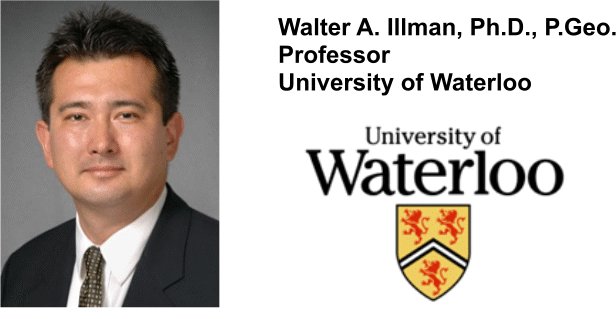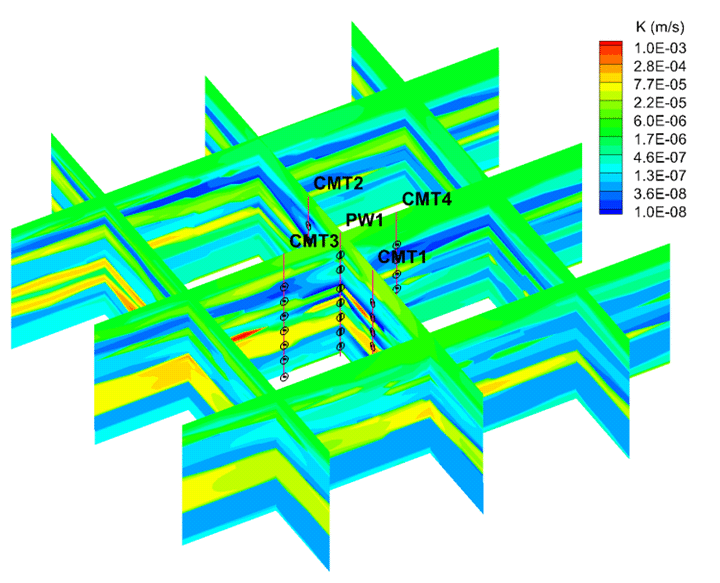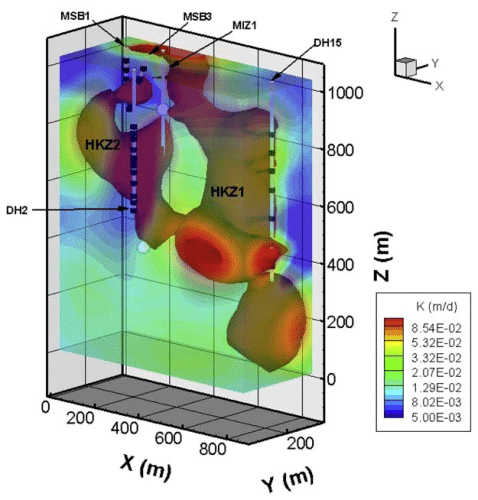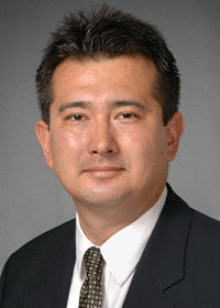Emerging Techniques in Hydraulic Testing for Fractured Rock:
Novel Analysis of Pumping Tests
Using Hydraulic Tomography

Hydraulic tomography is a new approach for creating images of subsurface heterogeneity in hydraulic conductivity (K) and specific storage (Ss) for both porous and fractured media.
Subsurface heterogeneity in fractured rock continues to challenge groundwater flow and solute transport models. This webinar shows how hydraulic tomography yields parameter estimates that are often measured more reliably than those obtained from traditional methods.
Background
Hydraulic Tomography is analogous to a "CAT-scan" in the medical sciences. It works similarly for ground water by using wells to hydraulically scan the subsurface by sequential aquifer tests (extraction, injection, and/or shutdown). The result is a high-resolution imagery depicting the most probable three-dimensional distributions of hydraulic conductivity (K) and specific storage (Ss) values (i.e., K- and Ss-"tomograms"), as well as their connectedness and uncertainty.

3-D distribution of hydraulic conductivity delineated by
hydraulic tomography in a highly heterogeneous glaciofluvial deposit.
Webinar Topics
Dr. Illman will introduce the concepts of hydraulic tomography and continue with how it is currently being used in both research and industry. Participants will learn the general steps to conduct a hydraulic tomography survey, interpret images, and how to assess the results.
Participants will learn how hydraulic tomography applies to both heterogeneous porous and fractured media. Recent advancements in the past few years will also be discussed. Finally, the webinar concludes with answers to commonly asked questions such as:
- How large of an area is hydraulic tomography applicable?
- What kind of resolution can one expect to achieve?
- How many pumping tests are needed to conduct a hydraulic tomography survey?
- How can we improve the resolution of tomograms?
- How good/reliable are these tomograms?
Webinar Highlights:
- Introduction to high-resolution hydraulic tomography.
- Review of traditional site characterization techniques and why they may not be enough to accurately map subsurface heterogeneity.
- Learn how hydraulic tomography can be used to demystify spatial distributions of hydraulic conductivity and specific storage as well as their uncertainty estimates.
- Steps for conducting a hydraulic tomography survey are then discussed.
- Case study at a highly heterogeneous glaciofluvial deposit is discussed.
- Case study at a fractured rock site is discussed.
- Recent advances with data integration to further improve results.

3-D distribution of hydraulic conductivity delineated by
hydraulic tomography in a kilometer-scale fractured granite site.
Instructors Bio
 Professor Illman has over 20 years of academic and consulting experience in a wide range of hydrogeological problems worldwide, particularly in developing high-resolution site characterization techniques, applying advanced groundwater flow and transport models, and developing innovative laboratory and field methods to solve complex environmental problems. His current research interests include field investigations of subsurface heterogeneity in both porous and fractured geologic media, in particular the innovative interpretation of single- and cross-hole hydraulic tests. He is considered one of the pioneers in developing hydraulic tomography, a new subsurface characterization method to image heterogeneities of hydraulic conductivity and specific storage. He has applied hydraulic tomography and related techniques in a variety of geological environments including highly heterogeneous porous and fractured media. Professor Illman is the author of over 60 publications in peer-reviewed journals and has served as an Associate Editor for Water Resources Research and Groundwater. Other notable published work includes a book on Bioremediation and Natural Attenuation: Process Fundamentals and Mathematical Models, published by John Wiley & Sons, Inc. of which he is a coauthor.
Professor Illman has over 20 years of academic and consulting experience in a wide range of hydrogeological problems worldwide, particularly in developing high-resolution site characterization techniques, applying advanced groundwater flow and transport models, and developing innovative laboratory and field methods to solve complex environmental problems. His current research interests include field investigations of subsurface heterogeneity in both porous and fractured geologic media, in particular the innovative interpretation of single- and cross-hole hydraulic tests. He is considered one of the pioneers in developing hydraulic tomography, a new subsurface characterization method to image heterogeneities of hydraulic conductivity and specific storage. He has applied hydraulic tomography and related techniques in a variety of geological environments including highly heterogeneous porous and fractured media. Professor Illman is the author of over 60 publications in peer-reviewed journals and has served as an Associate Editor for Water Resources Research and Groundwater. Other notable published work includes a book on Bioremediation and Natural Attenuation: Process Fundamentals and Mathematical Models, published by John Wiley & Sons, Inc. of which he is a coauthor.